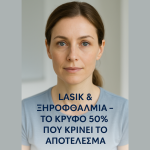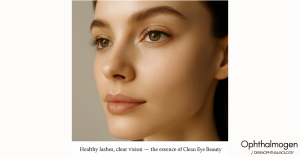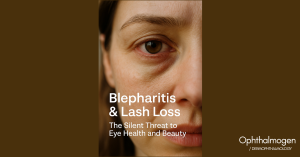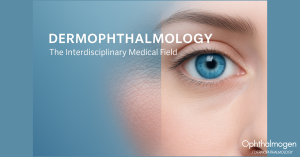
Introduction
Dark circles under the eyes are among the most common cosmetic complaints worldwide. Most people attribute them to lack of sleep, stress, or genetics. The usual solutions offered are cosmetic: concealers, fillers, or laser treatments.
However, modern science shows something deeper: dark circles are often a mirror of eye health. Conditions such as blepharitis, dry eye disease, allergic rhinitis, glaucoma, and even the side effects of medications can contribute to their development and intensity.
Dermophthalmology – the emerging field that unites ophthalmology and dermatology – reveals for the first time that health and appearance are inseparable.
What Are Dark Circles?
Dark circles are not a single disorder. They are a multifactorial condition caused by:
- changes in the skin,
- vascular and microcirculatory alterations,
- chronic eyelid inflammation,
- anatomical features of the eye area.
For some, they are mainly an aesthetic issue, while for others they represent an underlying medical symptom.
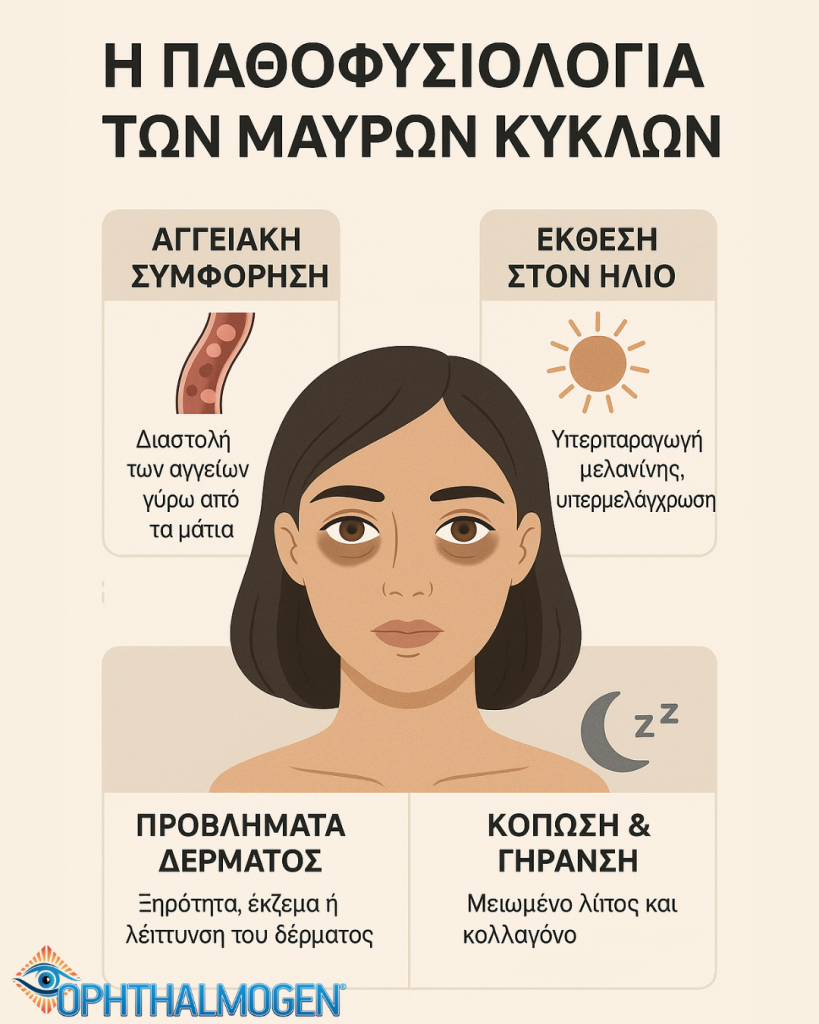
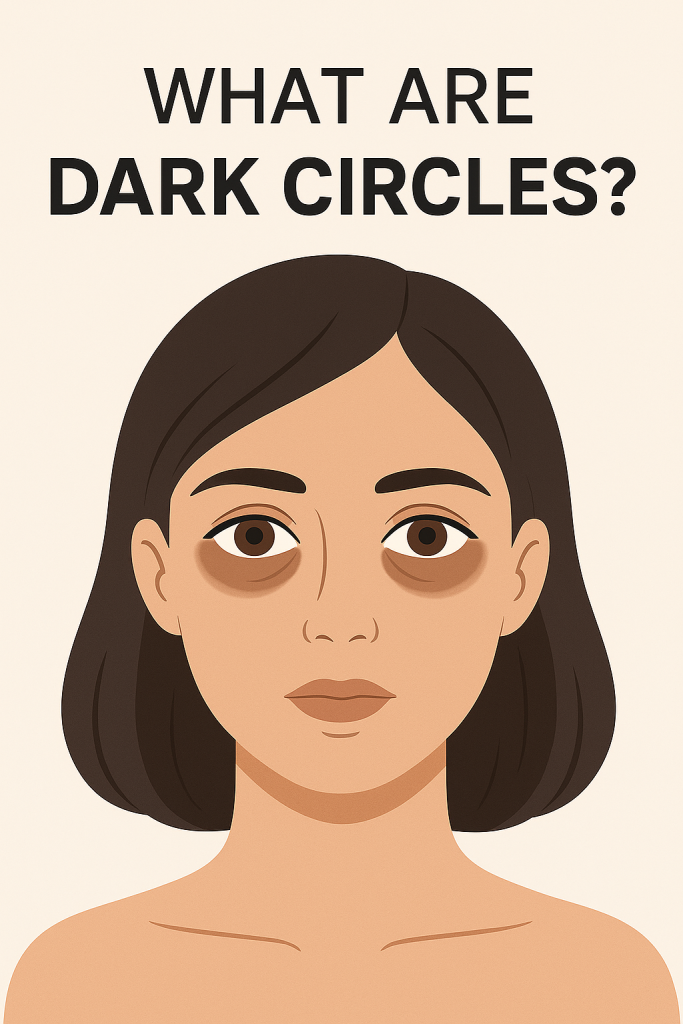
Pathophysiology – Why Dark Circles Form
- Reduced microcirculation → shadows.
- Thinner skin & collagen loss → visible veins.
- Loss of elasticity → hollow eyes.
- Presbyopia → ciliary fatigue, tired gaze.
- Dry eye & blepharitis → inflammation, dull appearance.
Types of Dark Circles
- Vascular Dark Circles– Bluish or purplish. – Caused by venous congestion and impaired microcirculation.
- Pigmented Dark Circles – Brown or black. – Due to hyperpigmentation of the skin (genetic, sun exposure, post-inflammatory changes).
- Structural/Anatomical Dark Circles – Result from tear trough deformity or loss of periorbital fat with age. – Shadows deepen due to skin sagging.
- Mixed Dark Circles – Combination of the above. – Most patients belong to this group, making treatment more complex.
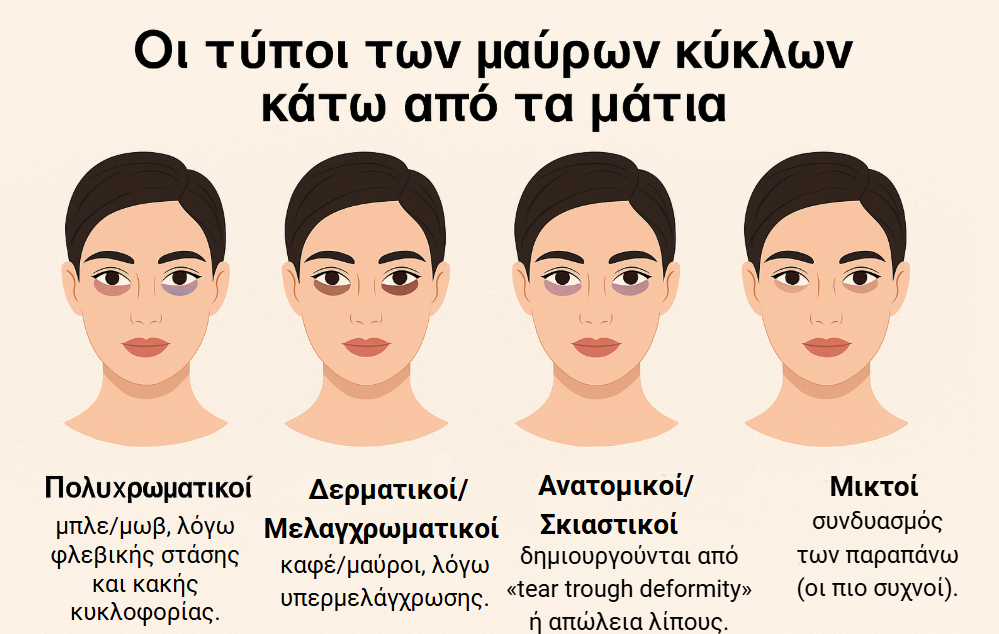
Medical Conditions Associated with Dark Circles
Blepharitis
• Affects 37–47% of patients in clinical practice, up to 68% in some studies. • Causes chronic eyelid inflammation, greasy scales, and swelling. • Results in heavy eyelids and shadows that accentuate dark circles.
Dry Eyes
• Affects 5–34% of the general population; prevalence rises to 70% in the elderly.
• Up to 60% of patients report a tired, dull look.
• Chronic ocular surface fatigue and unstable tear film make dark circles more pronounced.
Glaucoma
• Long-term use of glaucoma eye drops, especially prostaglandin analogues, is associated with: – Periorbital hyperpigmentation (10–20% of patients). – Periorbital fat atrophy (5–10%), leading to deeper hollows.
Allergic Rhinitis
• Affects 20–30% of the global population. • Children with chronic allergic rhinitis often show “allergic shiners”: dark circles caused by venous congestion. • Present in 40–50% of pediatric patients with allergies.
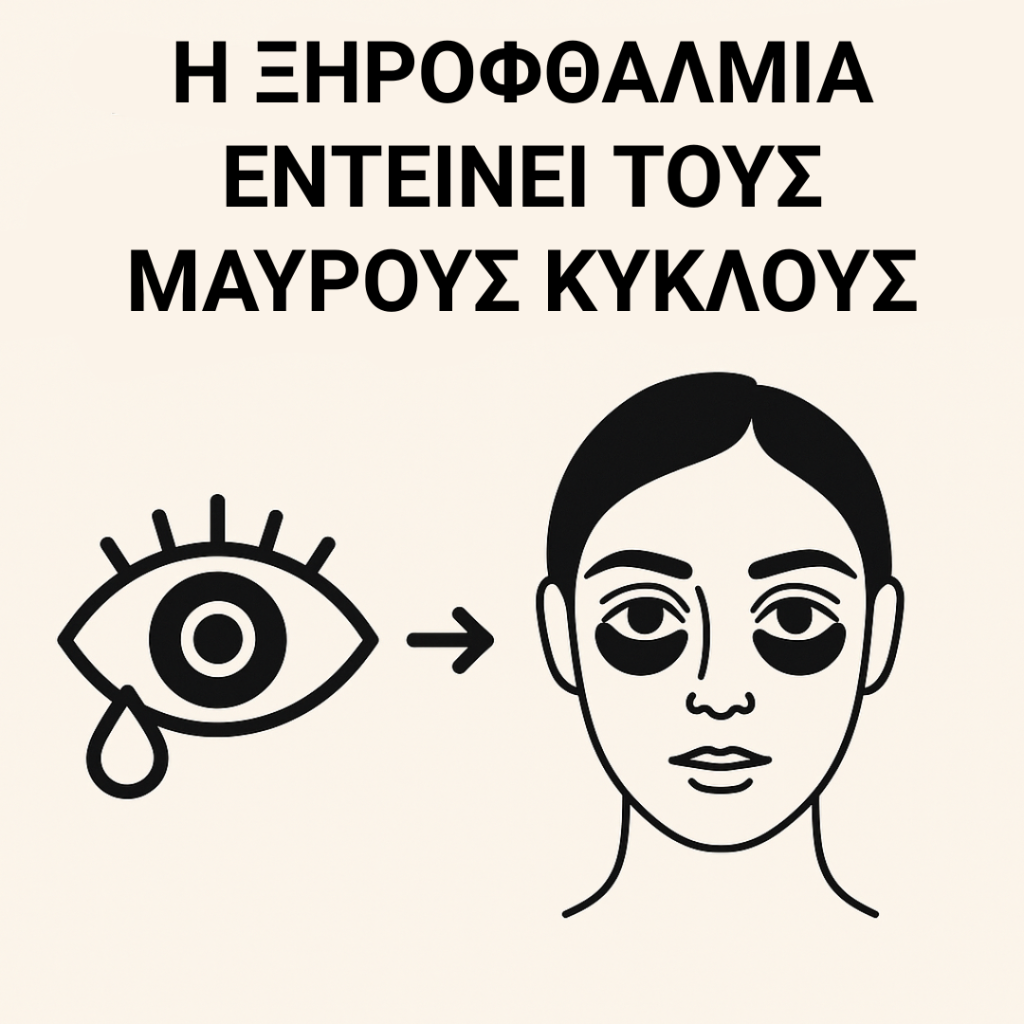
Presbyopia
• Eye strain due to loss of near vision can make the eyes appear heavy.
Aging
• Thinning of skin, loss of fat and collagen. • Blood vessels become more visible, making dark circles deeper with age.
Epiphora (Tearing Eyes)
• Chronic tearing (due to dry eye, allergies, or nasolacrimal duct obstruction) irritates the periocular skin, leading to darker, tired eyes.
Medications that Can Cause or Worsen Dark Circles
Ophthalmic Eye Drops (Glaucoma Therapy)
- Prostaglandin analogues (latanoprost, bimatoprost, travoprost): hyperpigmentation in 10–20% of patients.
- Beta-blockers (timolol): dry eye, tired look.
Antihistamines
- Cause ocular dryness and tear film instability in up to 25% of users. May also cause puffiness.
Antidepressants (SSRIs, tricyclics)
- Dry eye in 15–20% of patients.
- Sleep disturbances that worsen dark circles.
Antiepileptics & Sedatives
- Skin thinning in up to 30% of long-term users.
- Fluid retention → periocular puffiness.
Anticoagulants (aspirin, warfarin)
- Lead to easier bruising and periocular discoloration.
Hormonal Therapies (e.g., contraceptives)
- May trigger hyperpigmentation around the eyes.

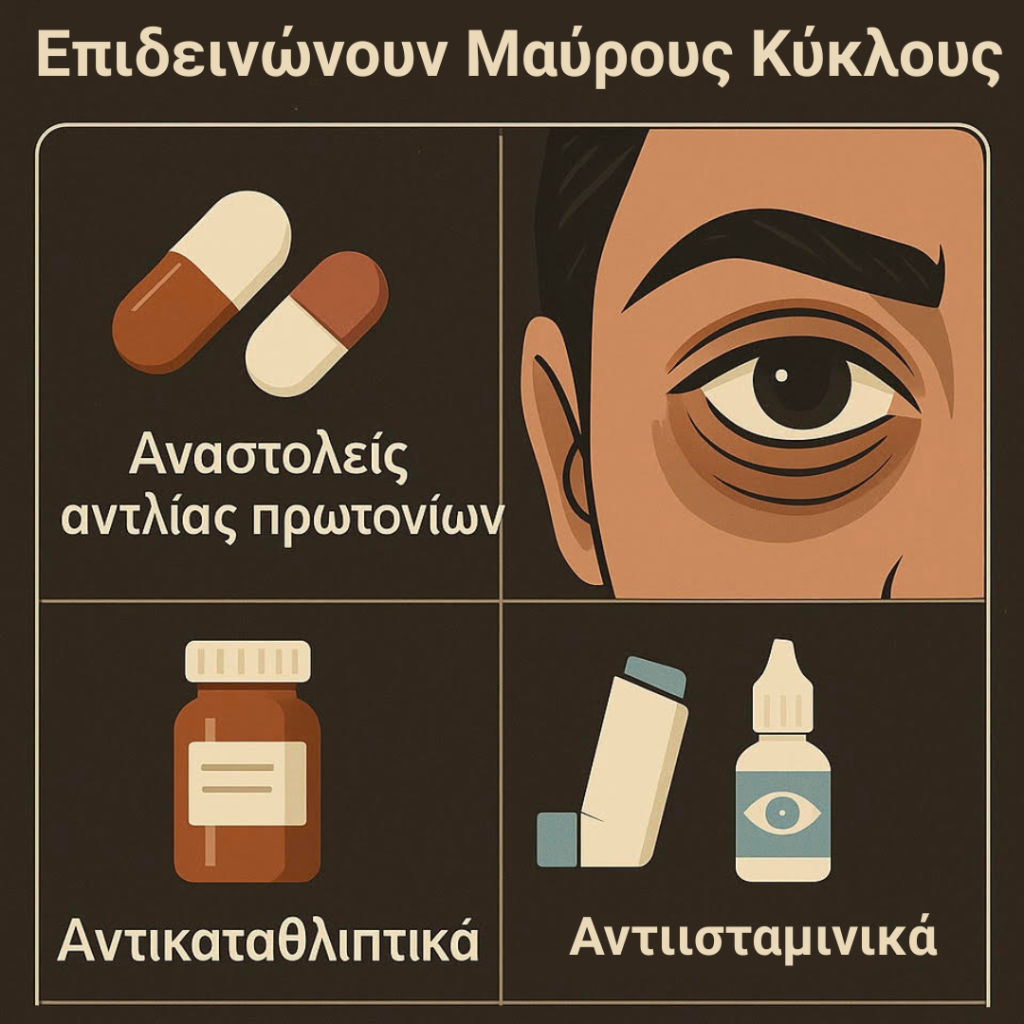
Complementary Solutions to Support Medical Therapy
Dark circles linked to medications do not mean treatment should be stopped. Instead, complementary care can help reduce their appearance:
- Daily eyelid hygiene with Ophthalmogen Spray & Gel → reduces inflammation and irritation.
- Self-heating compresses (Ophthalmogen EYE10) → improve microcirculation and meibomian gland function.
- Artificial tears with hyaluronic acid + vitamin B12 → relieve dryness caused by antihistamines or SSRIs.
- DermaLife 520 gel masks → reduce puffiness when used after heating compresses.
- Omega-3 supplements and antioxidants (C, E) → support vascular health.
- Periocular sunscreen → prevents hyperpigmentation from hormonal therapy or corticosteroids.
Epidemiology – Statistics and Data
- Dark circles: up to 40% of adults, 79% of students.
- Blepharitis: up to 68% of adults.
- Dry eye: 5–34% of the population, 70% in the elderly.
- Allergic rhinitis: 20–30% worldwide, with “allergic shiners” in 40–50% of children.
- •Glaucoma: hyperpigmentation from eye drops in 10–20% of patients.
Dry eye is a major factor that intensifies dark circles.
Diagnosis
- Dermatologist: skin type, pigmentation analysis.
- Ophthalmologist: tear film stability, slit lamp examination, blepharitis, Demodex evaluation.
- Medical history: medications, allergies, systemic conditions.
Treatment and Prevention
- Conservative: cleaning, compresses, artificial tears, supplements.
- Medical: laser, fillers (after the cause is resolved).
- Lifestyle: sleep, diet, smoking cessation, sunglasses.
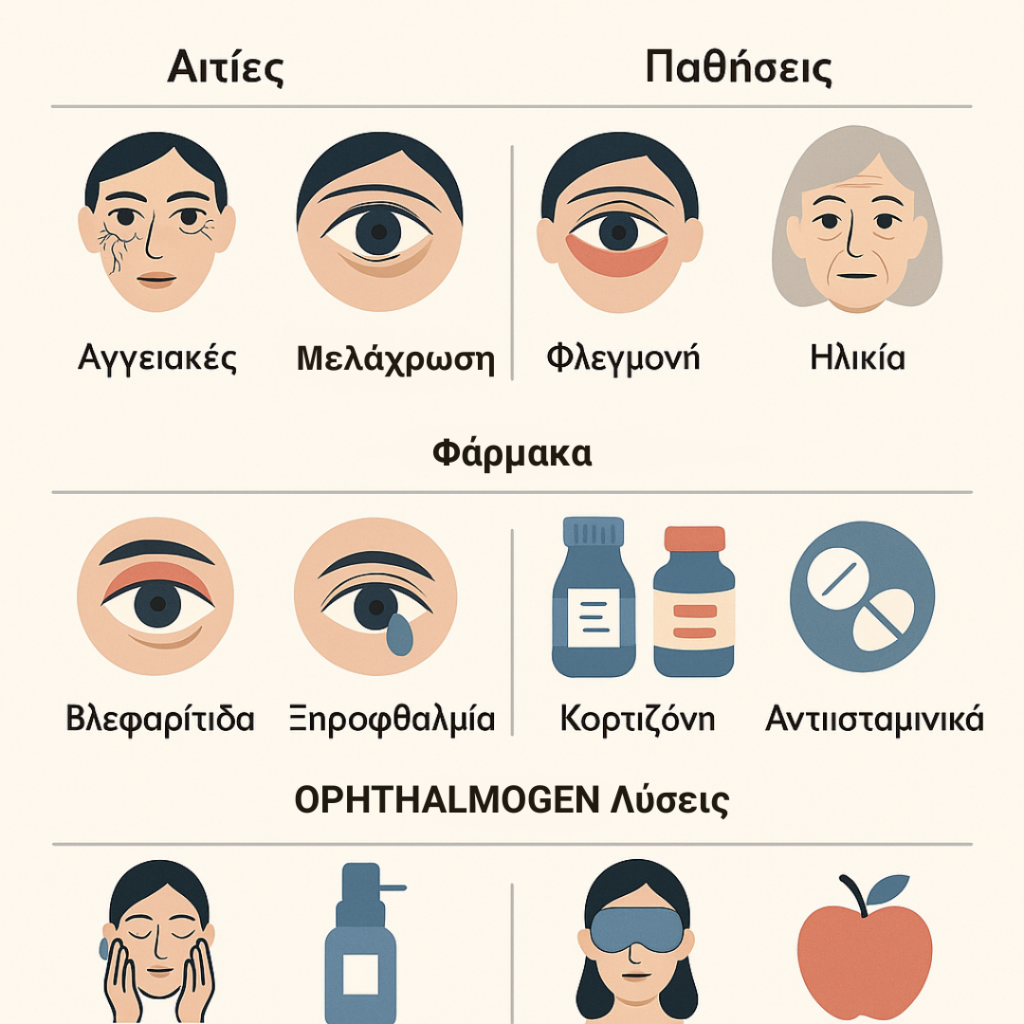
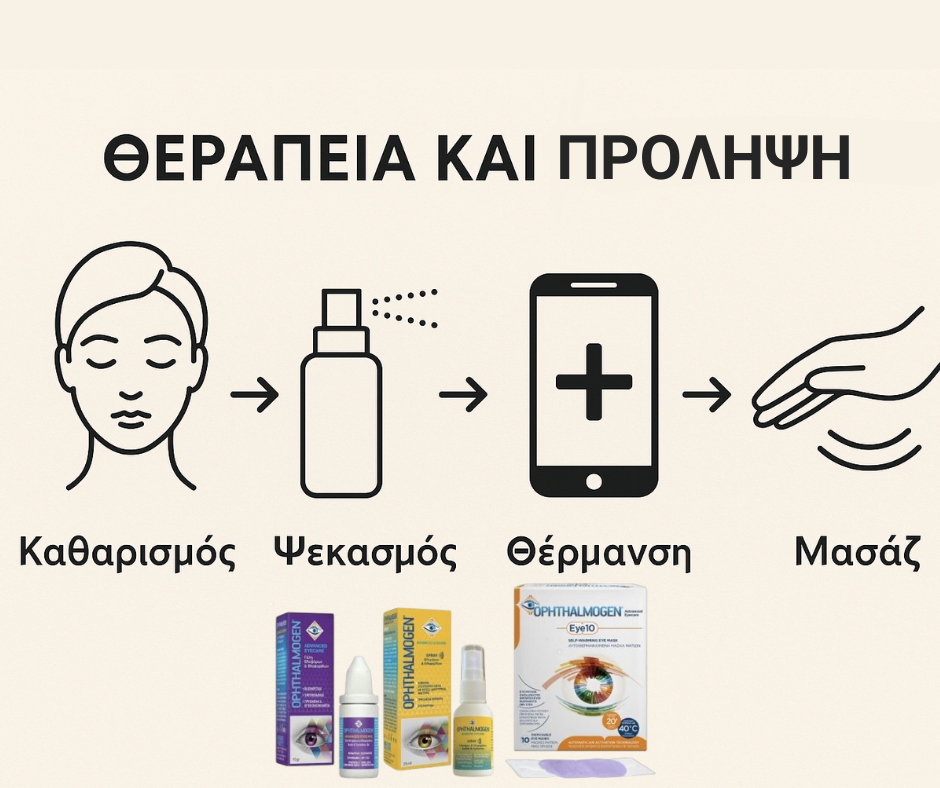
Case Studies
- Μαρία, 32 ετών – Μαύροι κύκλοι λόγω βλεφαρίτιδας & ξηροφθαλμίας → βελτίωση με OphthalmogenSpray&EYE
- Nick, 45 Long hours on screen, tearing, and dark circles. Treated with Ophthalmogen Gel, artificial tears, and EYE10. Performance and appearance improved.
- Helen, 60 Chronic dark circles, considering surgery. Diagnosed with Demodex blepharitis. With systematic eyelid hygiene, appearance improved without surgery.
FAQ
- Do dark circles disappear with sleep? No. Sleep helps, but if inflammation or dry eye is present, circles persist.
- Are cosmetics enough? Only temporarily. Without treating the cause, circles return.
- Can medications cause them? Yes, several categories.
- What should I do daily? Spray, Gel, EYE10, good hydration, diet with Omega-3.
- Are dark circles a health or beauty issue? Both. They are the clearest example that health and aesthetics are inseparable.
Conclusion
Dark circles under the eyes are not just a cosmetic issue.
They are often a warning sign of underlying conditions such as dry eye, blepharitis, allergies, glaucoma, or medication side effects.
Dermophthalmology provides a new, holistic approach:
with daily care, patients can achieve not only healthier eyes, but also a brighter appearance and better quality of life.
Dermophthalmology is the new medical specialty we have introduced (learn more at www.dermophthalmology.com)


